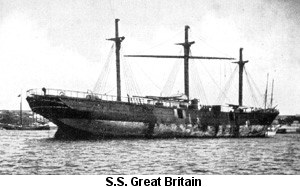
| Glasgow Digital Library | Voyage of the Scotia | BRUCE | PEOPLE | SHIP | ANTARCTIC | INDEX |
|---|

Scotia arrived in Port Stanley in the Falkland Islands on 6 January 1903. The ship was to stay there for three weeks during which time two years' worth of provisions were taken on including 200 tons of coal. The scientists were busy with magnetic surveys on the shore and setting up a meteorological station at Cape Pembroke - to be run by the lighthouse keeper.
Many old hulks were seen in Port Stanley harbour, ships which had just survived the journey around Cape Horn but were severely damaged. One of these was the first iron ship built as a transatlantic liner and the first to be driven by a propeller: Great Britain, designed by Isambard Kingdom Brunel. She had been launched in 1843 and made her first transatlantic voyage in 1845. She then went on the Australian run. After nearly 40 years of service she was severely damaged rounding Cape Horn and beached in Port Stanley where she was used for storing coal. In 1970 (127 years after she was launched) she was loaded on to a barge and towed back to Britain where she has been restored at a cost of £4 million and can now be seen in a dry dock in Bristol.
The Scottish National Antarctic Expedition sailed from Port Stanley on 26 January and quickly encountered the weather expected in the southern oceans. The ship was rolling 40° at one time and for a while she was 'hove to' with three bags of whale oil in the sea to stop the waves breaking. (Oil gradually leaks out of these bags.)
| Glasgow Digital Library | Voyage of the Scotia | BRUCE | PEOPLE | SHIP | ANTARCTIC | INDEX |
|---|